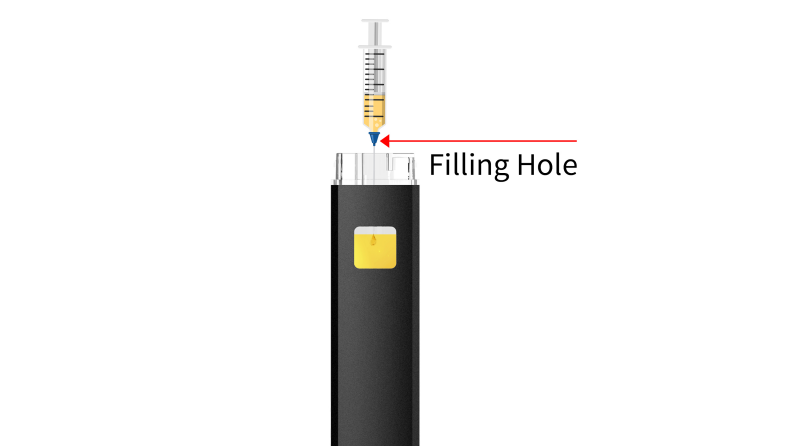Instructions for Filling Ds10 Disposable
December 15, 2023 – Denis G

The DS10 is a disposable cartridge (typical nominal capacity ~1.0 mL) built with a central fill port and a separate side airpath. It uses a ceramic Bcore heating element and a snap/press mouthpiece with a square silicone seal. Because of its design, correct filling technique — warm oil, middle-hole fill, careful seating of the mouthpiece and strict QC — is essential to prevent leaks, clogging and device failures.
Pre-checks
- Verify DS10 lot against PO and inspect randomly for physical defects (threads, gaskets, mouthpieces). Reject damaged units.
- Confirm oil batch identity, COA, and viscosity specs. Record supplier batch/lot and COA reference.
- Calibrate filling equipment and scales; confirm program parameters (fill volume, speed, dispense time).
- Prepare forms: batch log, inspection checklist, rework log.
Test batch
- Start with ~200 units as a pilot run to validate fill volume, function and QC results before scaling to full production. Record all findings and correct process parameters as needed.
Temperature & viscosity control
- Maintain oil handling temperature around 120°F (≈49°C) to achieve workable viscosity for filling.
- Do not overheat oil. Aim to fill at or below 120°F. If oil exceeds 120°F during warming, invert the cartridge after capping until oil returns to room temperature.
- Note product differences: distillates generally fill easier at these temps; live resin is thicker and may need closer temp control or slightly different handling. Adjust fill parameters per product type.
Recommended fill volume
- Target fill: 0.8 mL recommended for most customers (reduces leakage risk). Maximum safe fill: 1.0 mL (ensure headspace). Adjust per product spec.
Filling location & needle guidance
- Fill into the middle hole only. The side hole is the airpath — do not fill it (filling the side hole causes clogging and leakage).
- Use short needles and ensure the needle tip does not touch the bottom of the tank to avoid damaging ceramic components or localized overheating.
- Fill at a slow, steady rate to prevent air entrainment and bubbling. Purge syringe lines before each run.
Filling steps (production)
- Place DS10 into the filling jig so the device is vertical and stable; support the mouthpiece to avoid tilt.
- Warm the oil to target temp (~120°F) and confirm temperature with a calibrated probe.
- Purge lines and prime the needle. Position the needle at the middle hole and begin fill at the programmed slow rate.
- Stop the dispense slightly below the top to maintain headspace (target 0.8–1.0 mL depending on SKU).
- Allow a short settle time (a few seconds) for air to escape from the tank before capping.
- Wipe off any exterior oil immediately with an IPA wipe — do not use water.
- Seat the mouthpiece: press or torque to spec; press straight down and avoid excessive twisting or force. Pay attention to the square silicone seal in the center of the mouthpiece — ensure it is flat and fully seated before final press.
- Cap within 1 minute of filling to reduce weeping and contamination.
Post-fill QC checks
- Gravimetric verification: Weigh filled units or use inline volumetric checks. Log sample weights/volumes.
- Leak test: Perform ambient and, if required, elevated-temp leak test or pressure/vacuum check. Place units upside down for a brief visual leak screen.
- Draw / function test: Use puff tester or manual draw test to confirm airflow and absence of clogging. Keep the unit vertical during testing.
- Visual inspection: Confirm mouthpiece seating, clean exterior, correct label and batch code.
- Sampling frequency: Example: 1 full functional/gravimetric sample per 100–500 units; increase frequency for new SKUs or early production runs.
Handling & storage
- Store filled DS10s upright (mouthpiece up) to avoid weeping.
- Maintain recommended storage temperatures; avoid exposure to heat during transit. Advise customers to store upright and to vape with device vertical to reduce leaks/clogs.
Troubleshooting
- No vapor: usually casued by an air bubbles at bottom / no absorption into coil by low oil temp or too-rapid fill. Re-warm oil to ~120°F, slow the fill rate, and consider a short settling time before capping.
- Leakage: Causes include overfill, loose/misaligned mouthpiece, or damaged gasket. Action: quarantine, reduce fill volume (e.g., test 0.8 mL), verify seating torque, inspect seals.
- Clogging / poor draw: Check whether side hole was filled (airpath blocked) or oil viscosity is too high (live resin). If clogging persists, review airflow design or slightly increase fill temp within safe limits during handling.
- Mouthpiece mis-seat: Inspect fixture alignment and silicone seal. Replace unit if seal damaged.
Documentation & traceability
Record for each batch: DS10 lot number, oil batch/COA, fill machine ID and program, operator name, fill temperature, sample weights, leak/draw results, quantities accepted/rejected, and time/date. Retain records per regulatory retention requirements.
Compliance & labeling
Ensure filled products meet all state and local labeling, packaging and track-and-trace requirements. For disposables, include required warnings and “do not refill” statements when applicable.


0 comments